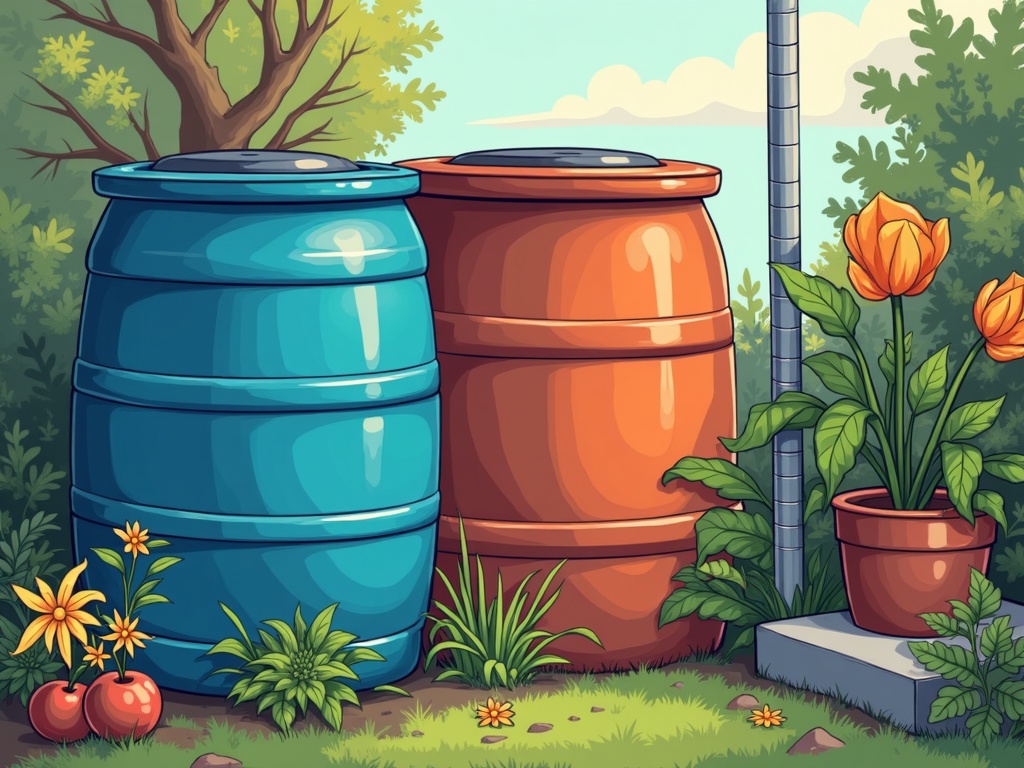How to Install a Rain Barrel: A Step-by-Step Guide
Imagine the satisfaction of watering your garden with free water, harvested directly from the sky. Rain barrels are a fantastic way to conserve water, reduce your water bill, and even help prevent stormwater runoff. Installing one might seem daunting, but with a little guidance, it’s a manageable project for any homeowner. This guide will walk you through the process, from choosing the right barrel to connecting it to your downspout.
Why Install a Rain Barrel?
Before we dive into the how-to, let’s quickly cover the why. Rain barrels offer a multitude of benefits:
- Water Conservation: Collect rainwater that would otherwise be lost to runoff.
- Cost Savings: Reduce your municipal water consumption, lowering your water bill.
- Eco-Friendly: Decrease stormwater runoff, which can pollute local waterways.
- Plant Health: Rainwater is naturally soft and free of chemicals like chlorine, making it ideal for plants.
- Emergency Water Supply: Have a backup water source for non-potable uses like flushing toilets (check local regulations).
Choosing the Right Rain Barrel
The first step is selecting a rain barrel that meets your needs. Consider the following factors:
- Size: Rain barrels typically range from 50 to 100 gallons. Choose a size that corresponds to your roof area and rainfall patterns. A larger roof area and more frequent rainfall will warrant a larger barrel.
- Material: Most rain barrels are made of plastic (polyethylene). Look for food-grade, UV-resistant materials to prevent degradation and contamination.
- Features: Key features to look for include a screened inlet to keep out debris and insects, an overflow valve to prevent overfilling, and a spigot for easy water access.
- Aesthetics: Rain barrels come in various shapes, sizes, and colors. Choose one that complements your home’s exterior. Some even mimic the look of terracotta pots or wooden barrels.
Tools and Materials You’ll Need
Here’s a list of the essential tools and materials for installing your rain barrel:
- Rain barrel(s)
- Downspout diverter kit (compatible with your downspout size)
- Drill with various sized bits
- Measuring tape
- Level
- Saw (hacksaw or reciprocating saw)
- Wrench or pliers
- Screwdriver
- Gravel or concrete blocks (for base)
- Optional: Flexible hose to extend spigot reach.
Step-by-Step Installation Guide
Now, let’s get to the installation process. Follow these steps for a successful rain barrel setup:
1. Prepare the Base
A full rain barrel can weigh hundreds of pounds, so it needs a stable and level base.
- Choose a Location: Select a spot near a downspout that’s relatively level. Ensure there’s enough space to comfortably access the spigot.
- Level the Ground: If the ground isn’t level, remove soil and compact it until you have a flat surface.
- Create a Base: Place gravel or concrete blocks on the leveled ground to create a solid foundation. This will also elevate the barrel, making it easier to access the spigot and improving drainage. A raised base of 6-12 inches is ideal. Use a level to ensure the base is perfectly horizontal.
2. Install the Downspout Diverter
The diverter is what directs rainwater from the downspout into the barrel. Different types of diverters exist, so carefully read the instructions included with your chosen kit. Generally, the installation involves these steps:
- Measure and Cut the Downspout: Determine the correct height for the diverter based on the rain barrel’s inlet location. Measure and mark the downspout accordingly. Use a saw to carefully cut the downspout at the marked location.
- Install the Diverter: Insert the diverter into the cut downspout, following the manufacturer’s instructions. This usually involves attaching the diverter to both the upper and lower sections of the cut downspout. Ensure the connection is secure and watertight.
- Connect the Diverter to the Barrel: Most diverter kits include a flexible hose or tube to connect the diverter to the rain barrel’s inlet. Attach one end of the hose to the diverter outlet and the other end to the rain barrel inlet. Secure the connections with clamps if necessary.
3. Position the Rain Barrel
Carefully place the rain barrel on the prepared base, ensuring it’s stable and level. Align the barrel’s inlet with the downspout diverter connection.
4. Connect the Overflow
Rain barrels need an overflow mechanism to prevent water from backing up into the downspout and potentially damaging your foundation.
- Locate the Overflow Outlet: Identify the overflow outlet on your rain barrel.
- Direct the Overflow: Attach a hose or pipe to the overflow outlet and direct it away from your foundation. Ideally, the overflow should drain into a designated area, such as a rain garden or a permeable surface. Avoid directing the overflow onto paved areas or towards your neighbor’s property.
5. Test the System
Wait for the next rainfall to test your newly installed rain barrel system. Observe the following:
- Water Flow: Ensure water flows smoothly from the downspout, through the diverter, and into the rain barrel.
- Leakage: Check for any leaks at the connections between the downspout, diverter, hose, and rain barrel. Tighten connections as needed.
- Overflow Functionality: Verify that the overflow mechanism works correctly when the barrel is full.
Maintaining Your Rain Barrel
To ensure your rain barrel system functions properly and lasts for years to come, regular maintenance is essential.
- Clean the Screen: Regularly clean the screen or mesh filter at the inlet to remove leaves, debris, and insects. This will prevent clogs and ensure water flows freely into the barrel.
- Check for Leaks: Periodically inspect the barrel and connections for leaks. Repair any leaks promptly to prevent water loss and potential damage.
- Empty the Barrel in Winter: In colder climates, empty the rain barrel before freezing temperatures arrive. Freezing water can expand and damage the barrel. Disconnect the diverter and reconnect the downspout for unimpeded drainage. Store your rain barrel indoors or turn it upside down to prevent water accumulation and freezing.
- Clean the Barrel Annually: Once a year, empty and clean the rain barrel to remove any sediment or algae buildup. Use a mild soap and water solution. Avoid using harsh chemicals or bleach, as they can harm plants.
Troubleshooting Common Issues
Even with careful installation and maintenance, you may encounter some common issues. Here’s how to troubleshoot them:
- Slow Filling: If the rain barrel fills slowly, check the screen for clogs. Also, ensure the diverter is properly positioned and functioning correctly.
- Leaks: Tighten all connections and inspect the barrel for cracks. Small cracks can be patched with sealant designed for plastic.
- Mosquitoes: Ensure the screen is intact and properly secured to prevent mosquitoes from entering the barrel. You can also add mosquito dunks (Bacillus thuringiensis israelensis) to the water; these are safe for plants and will kill mosquito larvae.
- Algae Growth: Algae growth is normal, especially in sunny locations. However, excessive algae can clog the system. Clean the barrel regularly to prevent buildup. Consider painting the barrel a darker color to reduce sunlight penetration.
Going Beyond One Barrel: Expanding Your System
Once you’ve experienced the benefits of a single rain barrel, you might consider expanding your system. You can connect multiple barrels together to increase your water storage capacity. Most rain barrels have connection points specifically designed for this purpose. Connecting multiple barrels is particularly useful if you have a large garden or experience periods of extended drought.
Using Rain Barrel Water Safely
While rainwater is generally safe for many uses, it’s important to be aware of potential contaminants. Rainwater can pick up pollutants from your roof, such as bird droppings, leaves, and chemicals from roofing materials. Therefore, it’s generally not recommended to use rain barrel water for drinking, cooking, or bathing without proper filtration and disinfection.
Here are some safe uses for rain barrel water:
- Watering gardens and lawns
- Washing cars
- Flushing toilets (check local regulations)
- Cleaning outdoor surfaces
If you intend to use rain barrel water for more sensitive purposes, consult with a water quality expert to determine the appropriate filtration and disinfection methods.
Local Regulations and Rebates
Before installing a rain barrel, check with your local municipality or homeowner’s association for any regulations or restrictions. Some areas may have specific requirements regarding rain barrel size, placement, or overflow management. Also, inquire about potential rebates or incentives for installing rain barrels. Many municipalities offer financial assistance to encourage water conservation.
Enjoy the Benefits of Rainwater Harvesting
Installing a rain barrel is a rewarding project that can save you money, conserve water, and benefit the environment. By following these steps, you can easily set up a system that provides you with a sustainable source of water for your garden and other outdoor needs. So, get started today and enjoy the satisfaction of harvesting rainwater!

